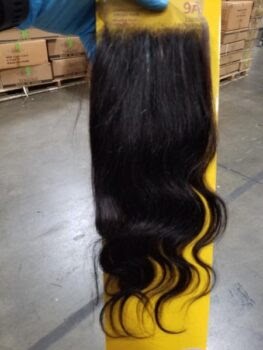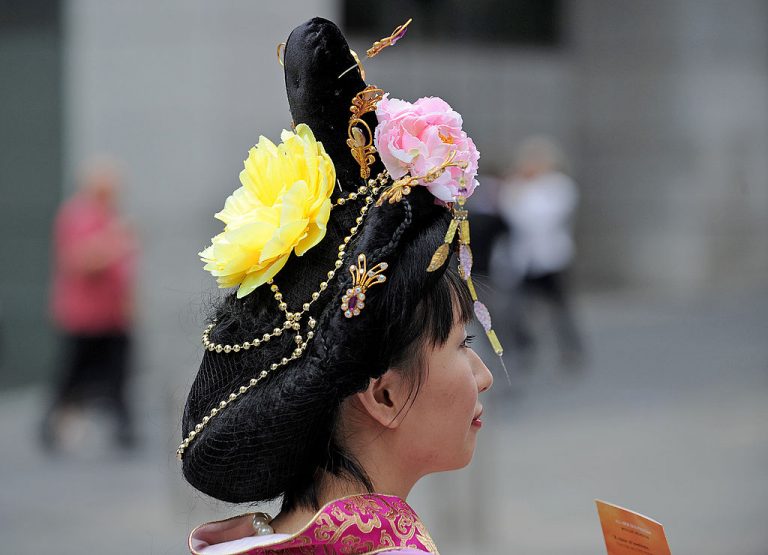Throughout the ages, Chinese culture has placed emphasis on women’s appearance, with beauty and demeanor traditionally being highly valued. It was said that when women of great beauty died, they were rewarded in the afterlife by living on as the deity of a flower. Wang Zhaojun, one of the four legendary beauties of ancient China, was admired by women of all ages as the ideal beauty, with her pale skin and dark hair. Many believe that she lives on as the deity of the peony flower to this day.
In ancient times, the hair was considered sacred, and a woman’s most feminine accessory. In Chinese culture, hair was believed to be a gift from one’s parents and all women grew their hair long. In the Han Dynasty (206 B.C. to 220 A.D.), women wore their hair up in loose buns with some untied hair hanging down their backs. The height of the art of hairdressing was the ability to combine the elements in the hair so that the existence of “the dragon hidden among the clouds” could only be guessed.
The Tang Dynasty (618 to 907 is celebrated as one of the most illustrious periods in Chinese history. Called the Golden Age of Chinese antiquity, the prosperity enjoyed at the time allowed women to display their beauty in the form of a large variety of new hairstyles. A typical Tang woman would arrange her hair in dangling hoops tied up on top of her head using ribbons and strings to form various shapes with the hair.

Hair accessories were not only necessary for keeping hairstyles in place, they also developed into an ornate culture. Hair sticks, carved from materials like bone, were worn as early as the Shang dynasty (1600 to 1050 B.C.). This form of beautification reached its height of popularity in the Tang and Song (960–1279) dynasties, when fine accessories were made of gold, silver, jade, and precious gems. One type of hair stick called “bu yao,” (步搖) or “swings with steps,” featured dangling adornments that swing as one walks. One had to keep a ladylike poise to avoid looking completely graceless with this accessory.
Hair sticks were once considered a sign of status. They were typically not worn until a woman “came of age” at 15. Royal concubines who committed grave sins had their rights to wearing hair sticks revoked. These days people enjoy making their own hair sticks and adorn them with silver, crystals, and glass beads.
Success
You are now signed up for our newsletter
Success
Check your email to complete sign up
Chinese people have always considered hair care and its symbolic value to be crucial. Long, shiny black hair was viewed as attractive and a sign of good health. The manner in which it was styled and combed demonstrated civil or social status or profession. Unmarried women would wear their hair down in order to show that they were single. Girls usually kept their hair braided until the age of 15, while little girls would have it tied in pretty knots. After marriage, a woman would wear her hair tied back. The only women who cut their hair were widows.
In fact, cutting hair was used as a form of punishment. Prisoners and criminals had their hair cut short and then left to grow unkempt. According to Confucius, shaving the hair cancels the personality, and unkempt hair was seen as a sign of illness or depression.
Communism destroys tradition and morality
Governed by the Chinese Communist Party (CCP), Chinese society today is highly influenced by Marxist thought. According to communist thinking, oppression is ingrained in the very culture of a society, and the only way to break free from that is to destroy the cultural norms “imposed” by traditional social morality. The Cultural Revolution saw China reject all things traditional, beautiful and honorable.
Feminism is pursued under the communist ideology claiming that it would save Chinese women from “old society” values and liberate them from the “male oppression.” They held that the patriarchy of the traditional family structure oppresses women, and traditional sexual morality represses human nature.
Yet the “liberation of mankind” that communism touts, has, instead of freeing people from “oppression,” made society into one where everyone struggles against his neighbor, brother, or teacher.
Needless to say, the art of fine hairstyles has largely disappeared.
Many ethnic minorities have resisted communism and held on to their traditional culture and so they are targeted for persecution. A ready example is the CCP’s genocide of the Uyghur population; a systematic, and profitable, destruction of their identity and culture.
Black Gold
The term “socialist market economy” was introduced by Jiang Zemin during the 14th National Congress of the Communist Party of China in 1992. Between the years 1984 and 2004, the use of Chinese women’s cosmetics and hair products export market grew from $25 million to $6 billion.
On July 1, 2020, U.S. Customs and Border Protection (CBP) seized a 13-ton shipment manufactured by the Lop County Meixin Hair Product Co. Ltd. China, valued at $800,000. Survivors, investigators, and Uyghur activist groups have said the seized hair comes from women held inside various concentration and labor camps in Xinjiang province. The seizure gave U.S. authorities the first piece of strong piece of evidence for further investigation into the persecution of the Muslim minority group.
Radio Free Asia (RFA) published the report Hair Product Industry Linked to Uyghur Forced Labor Booming in Xinjiang’s Lop County on May 28, 2020. Profit clearly overrides ethics in this industry.
Profit from persecution
Acclaimed China analyst and investigative journalist Ethan Gutmann provides a shocking account of the gruesome crimes against humanity perpetrated by China against the Uyghur ethnic minority and adherents of Falun Gong. Gutmann, who visited various camp survivors in Turkey and Kazakhstan, told The Epoch Times in an email: “My back-of-the-envelope calculation is that this [seized] shipment represents the hair of approximately 90,000 women, incarcerated in ‘re-education camps.’ Although this sort of long, exotic hair—deep chestnut browns, red highlights—are usually identified in Chinese catalogs with the euphemism ‘Mongolian,’ the hair is shaved from the heads of Uyghur, Kazakh, Kyrgyz, and Hui women.”

U.S. Customs and Border Protection on July 1, 2020. (Image: Courtesy of CBP)
On July 20, 2020, the Commerce Department added 11 Chinese companies implicated in abuses in Xinjiang, including the Hetian Haolin Hair Accessories Co. Ltd., to its entity list. This list is a tool to restrict the export, re-export, and transfer of products subject to export regulations by those persons or companies involved in activities that threaten the national security or the foreign policy interests of the United States.
Mihrigul Tursun, an Uighur mother of three, revealed that she suffered torture and brutal conditions at a “re-education camp in Xinjiang Province. According to her 2018 testimony before the U.S. Congress, she was detained three times from 2015 to 2017, once in a prison and twice in a concentration camp.
She said that three days after she arrived in prison, all 50 women in her cell had their hair cut off. “Everyone was depressed, emotionally shocked,” she said. They felt helpless and hopeless. “They felt dishonored. Even if it didn’t hurt them physically, it hurt them mentally, emotionally, and spiritually.” Her hair was waist-long when she entered the prison.

Tursun recounted how her mother used to braid her hair until she was 15. She recalled the many long-hair competitions in her school, and said that there were 12 to 15 kinds of braids used by Uyghur women along with many hair accessories.
Elfidar Hanim, secretary of the Uyghur American Association, told The Epoch Times that this importance given to growing long hair has been exploited by Chinese authorities, who are using hair from inmates in labor and concentration camps for profit.







